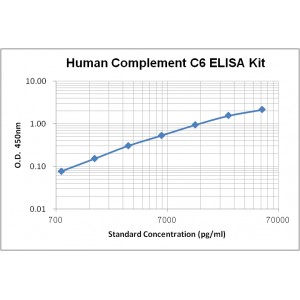More info
Assay Range | 781.5-50,000 pg/mL |
Sensitivity | 700 pg/mL |
Specificity | No cross-reaction with other related substances detected |
Size | 96T |
Storage | Store at 2 - 8ºC. Keep reconstituted standard and detection Ab at -20 ºC |
Assay Principle | Sandwich ELISA |
Sample Volume | 100 µL final volume, dilution factor varies on samples |
Detection Method | Chromogenic |
Kit Components
1. Recombinant Human C6 standard: 1 vial
2. One 96-well plate coated with Human C6 Ab
3. Diluent buffer (10x): 30 mL - 1
4. Biotinylated Human C6 Ab (50x): 140 µL
5. Streptavidin-HRP(100x): 80 µL
6. TMB developing agent: 8 mL x1
7. Stop solution: 12 mL x1
8. Washing solution (20x): 30 mL x2
Background
Human Complement Component 6 (C6) is a 913 amino acid single-chain glycoprotein with a molecular weight of 105 KDa. Each pathway of complement activation generates proteolytic enzyme complexes (C3/C5 convertases) which are bound to the target surface. These enzymes cleave a peptide bond in the larger alpha chain of C5 releasing the anaphylatoxin C5a and activating C5b. This is the only proteolytic step in the assembly of the C5b-9 complex. C6 is essential for formation of the membrane attack complex (MAC) and is activated non-proteolytically by binding to recently-formed C5b at the cell membrane. Cleavage of C5 into C5a and C5b by C5 convertase triggers binding of plasma C6 to C5b. Once the C5b-6 complex forms, C7, C8, and C9 add sequentially to create a transmembrane channel structure. In animal models, genetic C6 deficiency accelerates axonal regeneration and reduces atherosclerosis.


